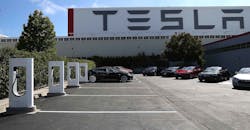Musk Fails to Quell Safety Doubts with Head-Scratching Data
Tesla Inc. would need to release more information than Elon Musk gave shareholders to set the record straight on the electric-car maker’s work-safety record, according to former occupational health officials who worked under the Obama administration.
The rate of injuries per person at Tesla is 6% below industry average so far this year, after being “a little bit above” average last year, the chief executive officer said during the company’s annual meeting Tuesday. The carmaker aims to lower the rate to half the auto industry average, he said, without saying by when or giving more specifics.
It’s difficult to assess Musk’s comments without more detail, according to David Michaels, who served as U.S. assistant secretary of labor for the Occupational Safety and Health Administration under Obama. The CEO made the claims after months of media reports about Tesla facing inspections by California’s work-safety regulator and allegations that the company may have under-reported workplace injuries.
“Injury rates are complex, and so it’s difficult to judge on the basis of a statement saying it’s 6% lower,” Michaels, who’s now a professor at George Washington University’s public health school, said in an interview. “I’d want to see the rates, but also the data on which they’re based.”
OSHA Inspections
Cal/OSHA opened at least two inspections of Tesla in April. One related to a subcontractor who was hospitalized after a piece of factory equipment struck him in the face and broke his jaw. The agency declined to say what triggered a second investigation, though it was initiated after the Center for Investigative Reporting’s news outlet Reveal published a story that said Tesla failed to report serious injuries as legally required.
Musk responded harshly to the Reveal report on Twitter, calling it “carefully constructed propaganda.”
Cal/OSHA requires large employers including Tesla to send injury rate data for 2017 by July 1, and Tesla could share that information with the public, Michaels said. Tesla has a big enough workforce that five months of information for 2018 could be valuable.
“In the interest of transparency, there’s no reason they couldn’t share those logs,” he said.
Year-Ago Claim
A Tesla spokesman declined to elaborate Wednesday on Musk’s comments. The Bureau of Labor Statistics releases average injury rates for the auto industry, though the most recent available data on its website is for 2016.
Tesla’s 2017 injury rate at its assembly plant in Fremont, California, was equivalent to the most recently published industry average, the company said in a February blog post.
The information shared in the blog post suggests that Tesla’s injury rate may have deteriorated in the second half of last year, as the company was beginning production of the Model 3 sedan. At Tesla’s annual meeting last year, Musk told shareholders that the company’s injury rate was 32% below the auto industry average and that the trend was “better and better with each passing month.”
“It takes a lot more to correct a systemic safety problem in a large company than just the CEO telling everyone to be safer,” said Jordan Barab, who served as deputy assistant secretary at OSHA under Obama and Michaels. “I’d have a lot of questions for him, like what’s changed about their safety program?”
Selling Safety
Before the annual meeting, Laurie Shelby, Tesla’s vice president of environmental health and safety, appeared at an American Society of Safety Engineers conference in San Antonio. She was asked along with a panel of other safety industry leaders what the barriers were to getting their senior executives to understand best practices.
“Safety is seen as not integrated into operations and into the process and into process improvements,” she said, without referring to Tesla specifically. “They’re seen as slowing down the process.”
“That’s our job, is to help the leaders understand it will speed up and it will make the process more effective, more efficient and have more resilience with safety built in,” Shelby said. “That is something we need to get better at.”
By Josh Eidelson and Dana Hull
About the Author
Bloomberg
Licensed content from Bloomberg, copyright 2016.
